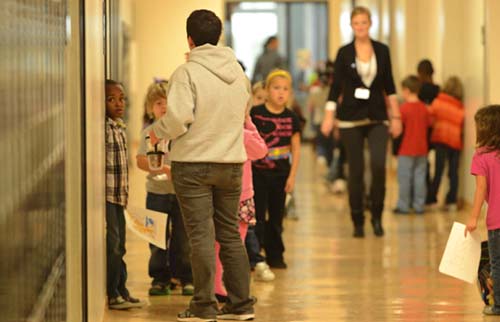On a bright May morning, with the school year drawing to a close, principal Craig Hockenberry stands outside Oyler School in a brand new blue suit, waiting to greet the latest crop of visitors.
Today’s group has traveled from Washington, D.C., to see what all the fuss is about in Cincinnati. Kaya Henderson, the chancellor of D. C. Public Schools is there. So is Randi Weingarten, president of the 1.5 million-member American Federation of Teachers.
They tour Oyler’s early childhood center, which cares for children from six weeks to five years old. They check out the vision clinic – the first of its kind in a public school – where kids from all over the district can come for free eye tests and glasses. They stop in at the health clinic, where a nurse practitioner gives annual check-ups and treats kids when they’re sick.
And Hockenberry rolls out one of his many Oyler tales. A story about how, before the clinic opened, he and a school secretary had to treat a child with a severe allergic reaction. The secretary administered the EpiPen upside down and stabbed herself with the needle instead. “You don’t want me giving your kids medicine,” Hockenberry says. “You want a professional doing that.”
Hockenberry, who is in his 12th year as principal, has this tour down. Since Oyler School reopened in August of 2012, it’s hosted a steady stream of visitors -- from New York to Knoxville to Kansas City. They’re all trying to find out how they might recreate some of Oyler’s success in their cities.
“Oyler School is this amazing manifestation of something that communities around the country should be doing,” says Weingarten, who heads one of the most powerful teachers unions in the country. “We need to actually help the whole child.” Weingarten has been a big promoter of community schools, which work with nonprofit and government partners to provide social services and enrichment programs alongside instruction.
All the attention around Oyler is new, but the school’s focus on community involvement is not. As far back as 1915, Oyler’s motto was “The school for the community and the community for the school.”
But the latest push really began in the early 2000s, when Cincinnati began turning all of its public schools into community learning centers to help address a crisis in the schools. Middle class families were fleeing the public schools en masse. Since 1970, enrollment had dropped by half.
Now, graduation rates are up, the achievement gap between black and white students has shrunk, and enrollment has stabilized. “We’re seeing middle class families moving back to Cincinnati,” says Darlene Kamine, executive director of Cincinnati’s Community Learning Center Institute.
There are more than 60 initiatives affiliated with the Coalition for Community Schools, a national group started in 1997, in places like Portland, Oakland, New York and Tulsa. “We’ve isolated poor children in very challenging places, in disinvested neighborhoods, and so it’s not easy to turn that around,” says Martin Blank, the coalition’s director. “But when you have good leadership and strong support, you can make that happen.”
Teachers also like the concept, because it lets them focus on teaching. “By addressing some of these needs it makes teaching in a low-income community a job a job that a regular human being can do the way it needs to be done,” says Timothy Daly, president of the New Teacher Project, a nonprofit group that aims to improve the quality of teaching in low-income schools.
But everyone agrees, services are not a substitute for better schools. And, while Oyler is making steady progress, it is still ranked in the bottom five percent of schools in the state of Ohio.
“You could wrap 100 services around an ineffective school and it won’t have any palpable affect on the achievement gap,” says Chester Finn, president of the Thomas B. Fordham Institute and former Assistant Secretary of Education in the Reagan Administration.
Finn says other factors have contributed to Cincinnati’s success – an effective superintendent and school board and a citywide initiative to bring together resources to help children succeed.
And he doubts community schools could work on a larger scale. An overcrowded school has no room for a dental clinic, for example. But as enrollments decline and more and more schools close in cities like Chicago and Philadelphia, support is growing for community schools.
And they don’t just work for poor children, says Kamine, with the Community Learning Center Institute. This year one of Cincinnati’s more affluent neighborhoods started its own community learning center, after watching the successes in poorer parts of the city. In places where the needs aren’t so basic, a community school might have more enrichment activities and career counseling, she says.
“I believe this is the answer for everybody, and it’s a different answer in every neighborhood, in every city, in every community,” says Kamine. “That’s what makes it work.“


